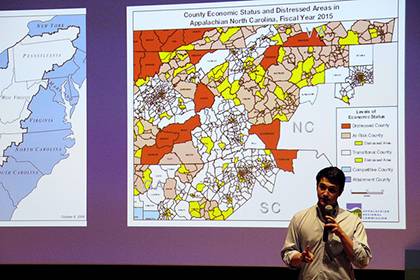
Undergraduates are at the heart of research for Bass Connections, and it is through their diligence and collaborative spirit that there was tremendous work done, Professor Thomas Nechyba said Wednesday night during the Education and Human Development Bass Connections showcase.
Hosted by the Social Science Research Institute, EHDxTalks covered both local and international projects, and topics ranged from education and nutrition at Duke to focuses on the psychological implications of transitional housing. Each of the 12 EHD Bass Connections teams presented five minute TEDx-style talks highlighting their discoveries, and their hopes for further research.
Brigid Burroughs, Jennifer Ling, Camila Vargas and Jaslyn Zhang explored gender discrepancies between men and women studying in STEM fields at Duke. Beginning with data analysis done by the National Girls’ Collaborative Project, the team tracked how men and women differently handled academic obstacles.
“After selecting majors, women are 50 percent more likely than men to switch out of a STEM major, even when controlling for academic ability. So clearly, the issue of a homogenous population among STEM majors is a systemic one,” Burroughs said.
The students said they wanted to continue their research and conduct experiments that would lead to recommendations. “We hope to see how different types of active learning affects self-efficacy, peer interaction and motivation in the classroom, and how these perceptions of learning affect gender,” Ling said.
In their project, Nikita Gawande and Saumya Jain study slums in Bangalore to help start filling in large gaps in scholarly knowledge about poverty in the developing world. The students use surveys to learn about the lives of people there and to develop policy recommendations on poverty, health, education, housing and other issues.
“We’re working on a methodology to classify slums into distinct types. Our hope is that by clustering slums on their physical features, it will be easier to discover what underlying factors are most important in shaping different trajectories of development over time,” Jain said.
“Eventually, our hope is that these types will help NGOs and governments come up with more specific and targeted policy interventions.”
Another team researched music therapy and autism in elementary schools. Giselle Graham and Xin Tong Lim’s project called “Voices Together” evaluated how music therapy can help overcome communication and social interaction deficits in children diagnosed with autism.
“Voices Together uses rhythm, tempo, and dynamics of music as a medium to implement therapeutic strategies focused on helping individuals with autism reach specific goals,” Graham said.
Serving as a culminating event to recognize student and faculty research, EHDxTalks became a platform for teams to share their achievements.
“Bass Connections is what happens at the intersection between higher education at Duke, interdisciplinary [research], and knowledge in the service of society,” Nechyba said.